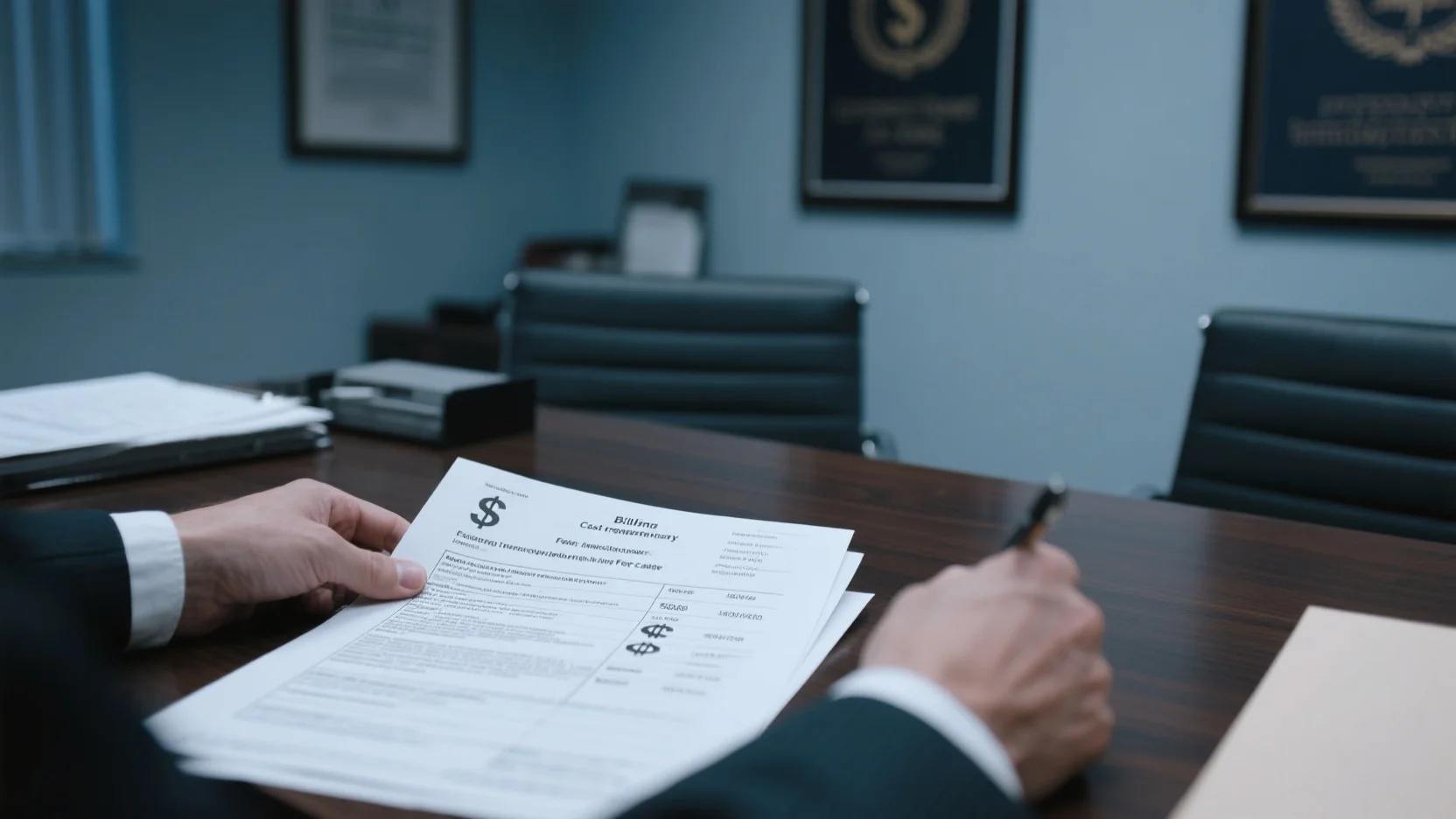
Image Source: unsplash
A detailed explanation of fee structures in personal injury legal services is essential for understanding legal fees, which in turn helps you make smarter choices in injury cases. These fee structures clarify when and how to pay lawyers. By knowing the fee details, you can select the best option for your needs.
Key Takeaways
- Contingency fees mean you pay your lawyer only if you win. This reduces money worries while your case is ongoing.
- Knowing the usual percentage for contingency fees helps you plan for costs as your case moves forward.
- Looking at other fee types, like hourly or flat fees, helps you pick the best choice for your budget.
Contingency Fees in Personal Injury Legal Services
How Contingency Fees Work
With contingency fees, you don’t pay upfront. Your lawyer gets paid only if you win. They take a percentage of the money you receive. Lawyers also cover early costs like court fees or expert help. This makes it easier for you financially during the case.
Contingency fees help people with less money get legal help. They are linked to big jury awards and recoveries.
This system pushes lawyers to do their best for you. Their payment depends on winning, so they aim for the highest payout.

Benefits of Contingency Fees
Contingency fees have many benefits:
- You don’t need to pay your lawyer right away.
- You can focus on healing without worrying about lawyer costs.
- Lawyers work harder since their pay depends on winning.
This is great if you can’t afford hourly or flat fees. The lawyer takes on the financial risk, giving you less to worry about.
Typical Percentage Ranges in Contingency Fee Agreements
The percentage lawyers take depends on how far your case goes. Before filing a lawsuit, they usually take 33%. If the case goes to court, it may rise to 40%. Appeals can increase it to 45%. These higher percentages reflect the extra work lawyers do as cases get harder.
- Most personal injury cases have fees between 33% and 40%.
- In places like Texas, lawyers often charge 33.33% before lawsuits and 40% during court cases.
Knowing these percentages helps you decide if this option works for you. It also prepares you for what to expect as your case moves forward.
Exploring Other Fee Structures in Personal Injury Cases
Hourly Rates and Their Use
Hourly rates mean you pay for each hour a lawyer works. This is less common in personal injury cases. It can be expensive because you pay no matter the result. Hourly rates usually range from $150 to $325. For complex cases or skilled lawyers, rates can go over $500.
Some lawyers charge hourly for tasks like writing documents or giving advice. You often get a monthly bill showing the hours worked. While this method is clear, it may not work if money is tight.
Flat Fees for Certain Legal Work
Flat fees are one set price for a specific legal job. For example, a lawyer might charge a flat fee to write a demand letter. This method is rare in personal injury cases. These cases often have unpredictable parts, like long talks or expert witnesses.
Flat fees help by giving you a clear cost upfront. But they are more common in simple legal jobs than in tricky personal injury cases.
Retainers and How They Work
Retainers are payments made upfront to hire a lawyer. The lawyer uses the retainer money as they work on your case. Retainers are more typical in ongoing legal issues than in personal injury cases.
| Fee Structure | Description | Common Usage |
|---|---|---|
| Retainer Fee | Upfront payment, billed hourly as work is done. | Ongoing legal matters |
| Contingency Fee | Lawyer gets paid a percentage of the settlement. | Personal injury cases |
Retainers give lawyers financial security but may not suit you as well as contingency fees. Retainers can be refundable or not, based on the agreement.
Extra Costs Besides Lawyer Fees
When handling a personal injury case, there are extra costs. These depend on how complicated your case is but are important for success.
Court Filing Costs
Starting a lawsuit means paying court filing fees. These fees usually range from $100 to $400, based on location. They cover the cost of officially starting your case. Other court costs, like juror payments or witness fees, might also come up. These fees may seem small but are necessary if your case goes to court.
Filing fees are required to make your case official in court.
Expert Witness Costs
Expert witnesses are key in personal injury cases. They use their knowledge to support your claims. For example, a doctor might explain your injuries, or an expert could show how the accident happened. These experts charge for their time, including meetings and court appearances. Costs can start at a few hundred dollars and go up to thousands for complex cases.
Costs for Records and Investigations
Collecting evidence means getting medical records, police reports, and other papers. Some records are free, but others may have small fees. If more investigation is needed, hiring a private investigator could cost hundreds. These costs are smaller than expert fees but still important for your case.
| Cost Type | Description |
|---|---|
| Court Costs | Filing fees from $100 to $400, juror payments, and witness fees. |
| Expert Witness Fees | Charges for experts, ranging from hundreds to thousands of dollars. |
| Administrative Costs | Expenses for mail, research, travel, and trial materials, adding up fast. |
| Deposition Costs | Fees for recording witness statements, about $500 for long sessions. |
| Investigation Costs | Small fees for evidence, with private investigators costing hundreds. |
Knowing these extra costs helps you plan for your case. Understanding fee structures ensures you are ready for what’s ahead.
Picking the Best Fee Structure for Your Case
Checking Your Money Situation
First, look at how much money you have. If you can’t pay upfront, contingency fees might work best. With this, your lawyer only gets paid if you win. This lowers money worries during your case. Flat fees, however, mean one set payment no matter the result. These are less common in injury cases but show costs clearly.
Other fee types, like hourly rates or retainers, may not fit everyone. Hourly fees can grow fast, especially in tough cases. Retainers need upfront money, which isn’t great if funds are tight.
Here’s a simple fee structure chart:
| Fee Type | What It Means |
|---|---|
| Contingency Fee | Pay only if you win; no win, no fee. |
| Hourly Rate | Pay for each hour worked, win or lose. |
| Flat Fee | One set price agreed at the start. |
| Retainer Fee | Pay upfront; lawyer uses it as they work. |
Thinking About How Hard Your Case Is
How tricky your case is affects the fee choice. Easy cases often have lower fees, about 33%. Medium cases may need 35%, and hard ones can go up to 40%. Appeals make fees even higher, sometimes 45%. Lawyers charge more for tough cases because they take more effort.
For example, in Texas, fees start at 33.33% before lawsuits. They rise to 40% during court cases. Appeals add more work, so fees go up again. Knowing your case’s difficulty helps you plan for costs.
| Case Type | Contingency Fee Percentage |
|---|---|
| Easy | 33% |
| Medium | 35% |
| Hard | 40% |
Talking to Lawyers to Compare Fees
Talk to several lawyers to find the best deal. Each lawyer may have different terms based on your case. Some include costs like expert fees, while others don’t. Ask for a full list of fees to avoid surprises.
When meeting lawyers, check how fees fit your budget. Many offer free first meetings, so you can compare without spending money. By talking to different lawyers, you’ll find a fee plan that works for your case and wallet.
Tip: Always get a written fee agreement before hiring a lawyer.
- Contingency fees are the top choice for injury cases.
- They ease money worries and push lawyers to do well.
- But, look at other fee types and extra costs too.
- Talk to a skilled lawyer to pick the best option.
FAQ
What if you lose your case with a contingency fee?
If you lose, you don’t pay your lawyer. Contingency fees only apply if you win. But, you may still need to pay for things like court or expert fees.
Can you ask for a lower contingency fee percentage?
Yes, you can ask to lower it. Many lawyers are willing to talk about their rates. Make sure the percentage is written clearly in your agreement.
Are retainers returned if you stop using your lawyer?
It depends on the deal. Some retainers return unused money, but others don’t. Always check the terms before signing a retainer agreement.


